Case Study: Data Analytics Impact on Southwest Airlines Services
VerifiedAdded on 2023/06/05
|17
|3673
|351
Case Study
AI Summary
This case study examines Southwest Airlines' Baltimore station, focusing on how data analytics and process analysis contribute to service and network productivity. The study highlights the challenges faced by the airline, including staffing shortages due to rapid expansion, and the strategies implemented to overcome these challenges. These strategies include minimizing ground time, using a single aircraft operating platform, utilizing less congested airports, offering limited services, and promoting teamwork and effective communication. The analysis also explores the mapping of existing services at the Baltimore airport, the deployment of an open service ecosystem, and the application of the Service Strategy Triad and customer journey maps. The case study emphasizes the importance of understanding customer needs, identifying touchpoints, and developing personas to enhance customer satisfaction and improve the overall service delivery system.

Services and Network productivity with Data Analytics.
Process analysis
Student Name
Course Name
Professor’s Name
School
The City and State where it is located
Date
Process analysis
Student Name
Course Name
Professor’s Name
School
The City and State where it is located
Date
Paraphrase This Document
Need a fresh take? Get an instant paraphrase of this document with our AI Paraphraser
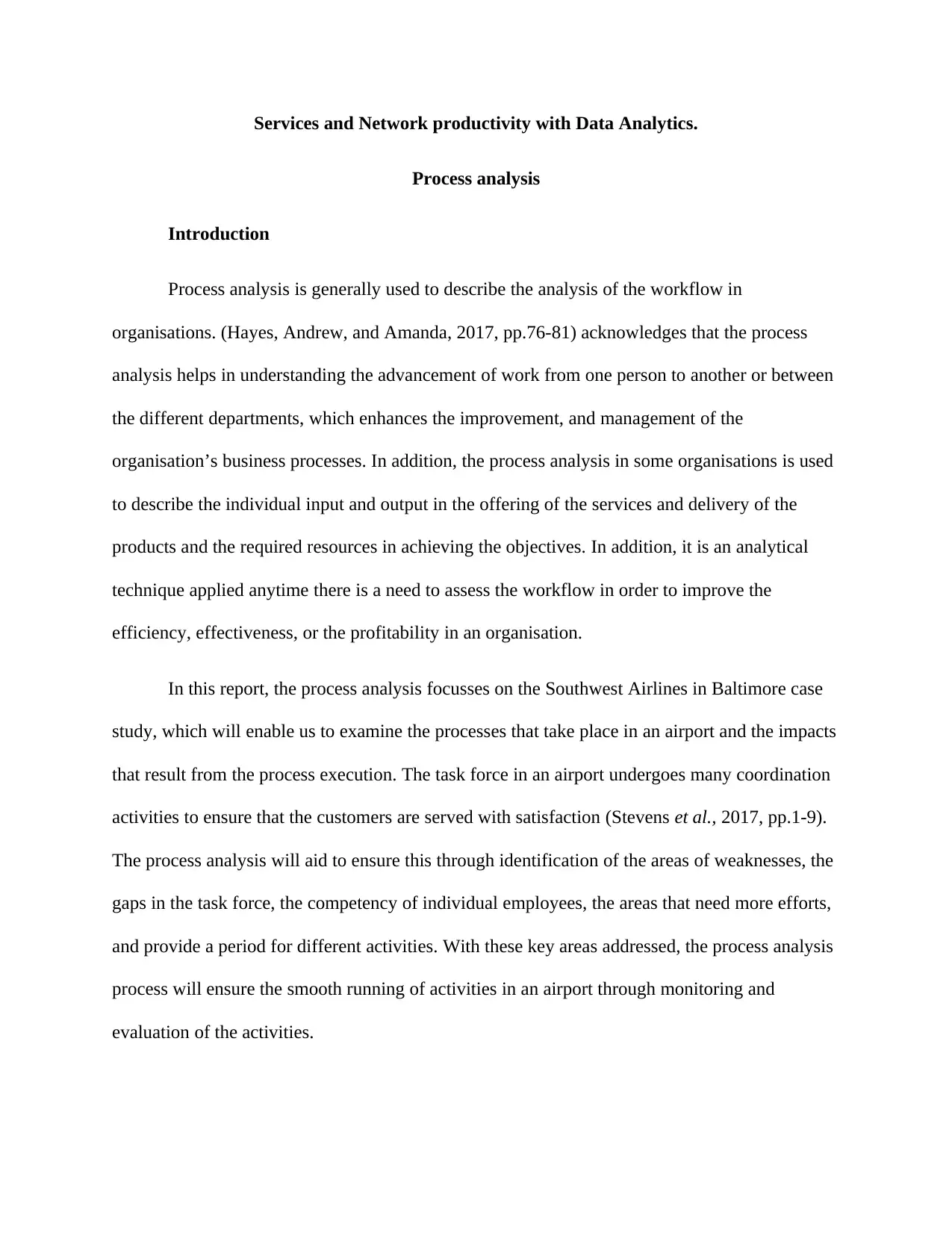
Services and Network productivity with Data Analytics.
Process analysis
Introduction
Process analysis is generally used to describe the analysis of the workflow in
organisations. (Hayes, Andrew, and Amanda, 2017, pp.76-81) acknowledges that the process
analysis helps in understanding the advancement of work from one person to another or between
the different departments, which enhances the improvement, and management of the
organisation’s business processes. In addition, the process analysis in some organisations is used
to describe the individual input and output in the offering of the services and delivery of the
products and the required resources in achieving the objectives. In addition, it is an analytical
technique applied anytime there is a need to assess the workflow in order to improve the
efficiency, effectiveness, or the profitability in an organisation.
In this report, the process analysis focusses on the Southwest Airlines in Baltimore case
study, which will enable us to examine the processes that take place in an airport and the impacts
that result from the process execution. The task force in an airport undergoes many coordination
activities to ensure that the customers are served with satisfaction (Stevens et al., 2017, pp.1-9).
The process analysis will aid to ensure this through identification of the areas of weaknesses, the
gaps in the task force, the competency of individual employees, the areas that need more efforts,
and provide a period for different activities. With these key areas addressed, the process analysis
process will ensure the smooth running of activities in an airport through monitoring and
evaluation of the activities.
Process analysis
Introduction
Process analysis is generally used to describe the analysis of the workflow in
organisations. (Hayes, Andrew, and Amanda, 2017, pp.76-81) acknowledges that the process
analysis helps in understanding the advancement of work from one person to another or between
the different departments, which enhances the improvement, and management of the
organisation’s business processes. In addition, the process analysis in some organisations is used
to describe the individual input and output in the offering of the services and delivery of the
products and the required resources in achieving the objectives. In addition, it is an analytical
technique applied anytime there is a need to assess the workflow in order to improve the
efficiency, effectiveness, or the profitability in an organisation.
In this report, the process analysis focusses on the Southwest Airlines in Baltimore case
study, which will enable us to examine the processes that take place in an airport and the impacts
that result from the process execution. The task force in an airport undergoes many coordination
activities to ensure that the customers are served with satisfaction (Stevens et al., 2017, pp.1-9).
The process analysis will aid to ensure this through identification of the areas of weaknesses, the
gaps in the task force, the competency of individual employees, the areas that need more efforts,
and provide a period for different activities. With these key areas addressed, the process analysis
process will ensure the smooth running of activities in an airport through monitoring and
evaluation of the activities.
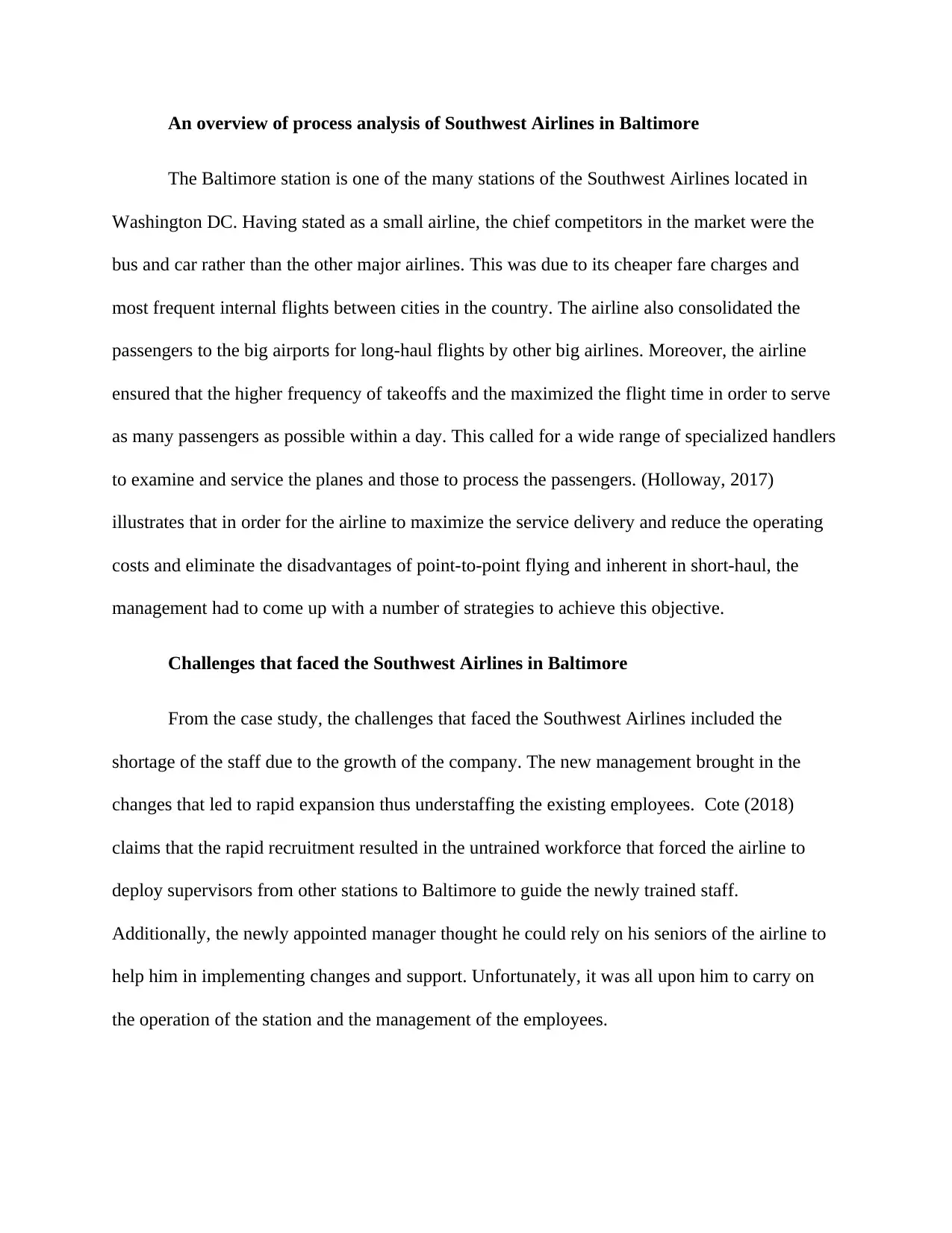
An overview of process analysis of Southwest Airlines in Baltimore
The Baltimore station is one of the many stations of the Southwest Airlines located in
Washington DC. Having stated as a small airline, the chief competitors in the market were the
bus and car rather than the other major airlines. This was due to its cheaper fare charges and
most frequent internal flights between cities in the country. The airline also consolidated the
passengers to the big airports for long-haul flights by other big airlines. Moreover, the airline
ensured that the higher frequency of takeoffs and the maximized the flight time in order to serve
as many passengers as possible within a day. This called for a wide range of specialized handlers
to examine and service the planes and those to process the passengers. (Holloway, 2017)
illustrates that in order for the airline to maximize the service delivery and reduce the operating
costs and eliminate the disadvantages of point-to-point flying and inherent in short-haul, the
management had to come up with a number of strategies to achieve this objective.
Challenges that faced the Southwest Airlines in Baltimore
From the case study, the challenges that faced the Southwest Airlines included the
shortage of the staff due to the growth of the company. The new management brought in the
changes that led to rapid expansion thus understaffing the existing employees. Cote (2018)
claims that the rapid recruitment resulted in the untrained workforce that forced the airline to
deploy supervisors from other stations to Baltimore to guide the newly trained staff.
Additionally, the newly appointed manager thought he could rely on his seniors of the airline to
help him in implementing changes and support. Unfortunately, it was all upon him to carry on
the operation of the station and the management of the employees.
The Baltimore station is one of the many stations of the Southwest Airlines located in
Washington DC. Having stated as a small airline, the chief competitors in the market were the
bus and car rather than the other major airlines. This was due to its cheaper fare charges and
most frequent internal flights between cities in the country. The airline also consolidated the
passengers to the big airports for long-haul flights by other big airlines. Moreover, the airline
ensured that the higher frequency of takeoffs and the maximized the flight time in order to serve
as many passengers as possible within a day. This called for a wide range of specialized handlers
to examine and service the planes and those to process the passengers. (Holloway, 2017)
illustrates that in order for the airline to maximize the service delivery and reduce the operating
costs and eliminate the disadvantages of point-to-point flying and inherent in short-haul, the
management had to come up with a number of strategies to achieve this objective.
Challenges that faced the Southwest Airlines in Baltimore
From the case study, the challenges that faced the Southwest Airlines included the
shortage of the staff due to the growth of the company. The new management brought in the
changes that led to rapid expansion thus understaffing the existing employees. Cote (2018)
claims that the rapid recruitment resulted in the untrained workforce that forced the airline to
deploy supervisors from other stations to Baltimore to guide the newly trained staff.
Additionally, the newly appointed manager thought he could rely on his seniors of the airline to
help him in implementing changes and support. Unfortunately, it was all upon him to carry on
the operation of the station and the management of the employees.
⊘ This is a preview!⊘
Do you want full access?
Subscribe today to unlock all pages.

Trusted by 1+ million students worldwide
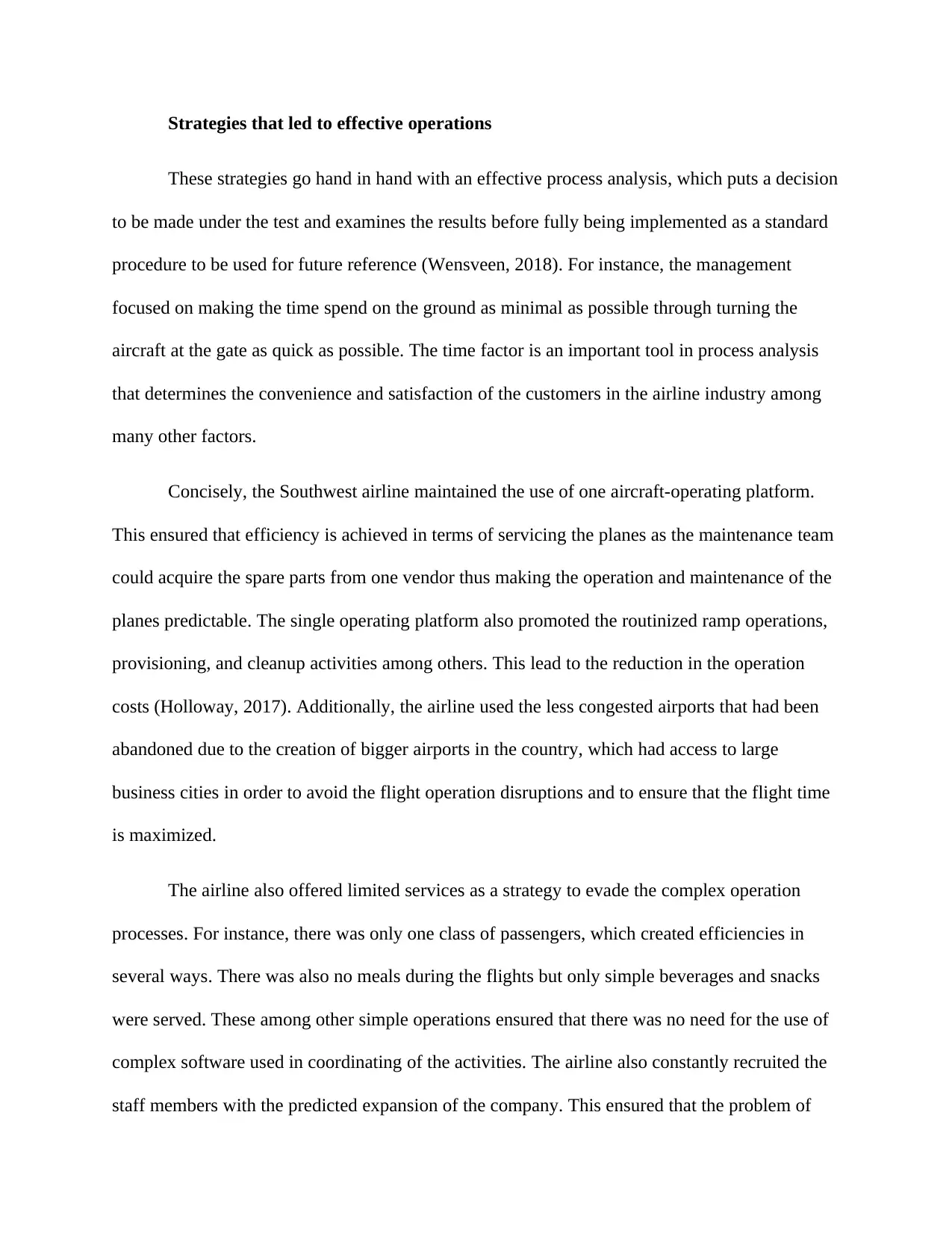
Strategies that led to effective operations
These strategies go hand in hand with an effective process analysis, which puts a decision
to be made under the test and examines the results before fully being implemented as a standard
procedure to be used for future reference (Wensveen, 2018). For instance, the management
focused on making the time spend on the ground as minimal as possible through turning the
aircraft at the gate as quick as possible. The time factor is an important tool in process analysis
that determines the convenience and satisfaction of the customers in the airline industry among
many other factors.
Concisely, the Southwest airline maintained the use of one aircraft-operating platform.
This ensured that efficiency is achieved in terms of servicing the planes as the maintenance team
could acquire the spare parts from one vendor thus making the operation and maintenance of the
planes predictable. The single operating platform also promoted the routinized ramp operations,
provisioning, and cleanup activities among others. This lead to the reduction in the operation
costs (Holloway, 2017). Additionally, the airline used the less congested airports that had been
abandoned due to the creation of bigger airports in the country, which had access to large
business cities in order to avoid the flight operation disruptions and to ensure that the flight time
is maximized.
The airline also offered limited services as a strategy to evade the complex operation
processes. For instance, there was only one class of passengers, which created efficiencies in
several ways. There was also no meals during the flights but only simple beverages and snacks
were served. These among other simple operations ensured that there was no need for the use of
complex software used in coordinating of the activities. The airline also constantly recruited the
staff members with the predicted expansion of the company. This ensured that the problem of
These strategies go hand in hand with an effective process analysis, which puts a decision
to be made under the test and examines the results before fully being implemented as a standard
procedure to be used for future reference (Wensveen, 2018). For instance, the management
focused on making the time spend on the ground as minimal as possible through turning the
aircraft at the gate as quick as possible. The time factor is an important tool in process analysis
that determines the convenience and satisfaction of the customers in the airline industry among
many other factors.
Concisely, the Southwest airline maintained the use of one aircraft-operating platform.
This ensured that efficiency is achieved in terms of servicing the planes as the maintenance team
could acquire the spare parts from one vendor thus making the operation and maintenance of the
planes predictable. The single operating platform also promoted the routinized ramp operations,
provisioning, and cleanup activities among others. This lead to the reduction in the operation
costs (Holloway, 2017). Additionally, the airline used the less congested airports that had been
abandoned due to the creation of bigger airports in the country, which had access to large
business cities in order to avoid the flight operation disruptions and to ensure that the flight time
is maximized.
The airline also offered limited services as a strategy to evade the complex operation
processes. For instance, there was only one class of passengers, which created efficiencies in
several ways. There was also no meals during the flights but only simple beverages and snacks
were served. These among other simple operations ensured that there was no need for the use of
complex software used in coordinating of the activities. The airline also constantly recruited the
staff members with the predicted expansion of the company. This ensured that the problem of
Paraphrase This Document
Need a fresh take? Get an instant paraphrase of this document with our AI Paraphraser
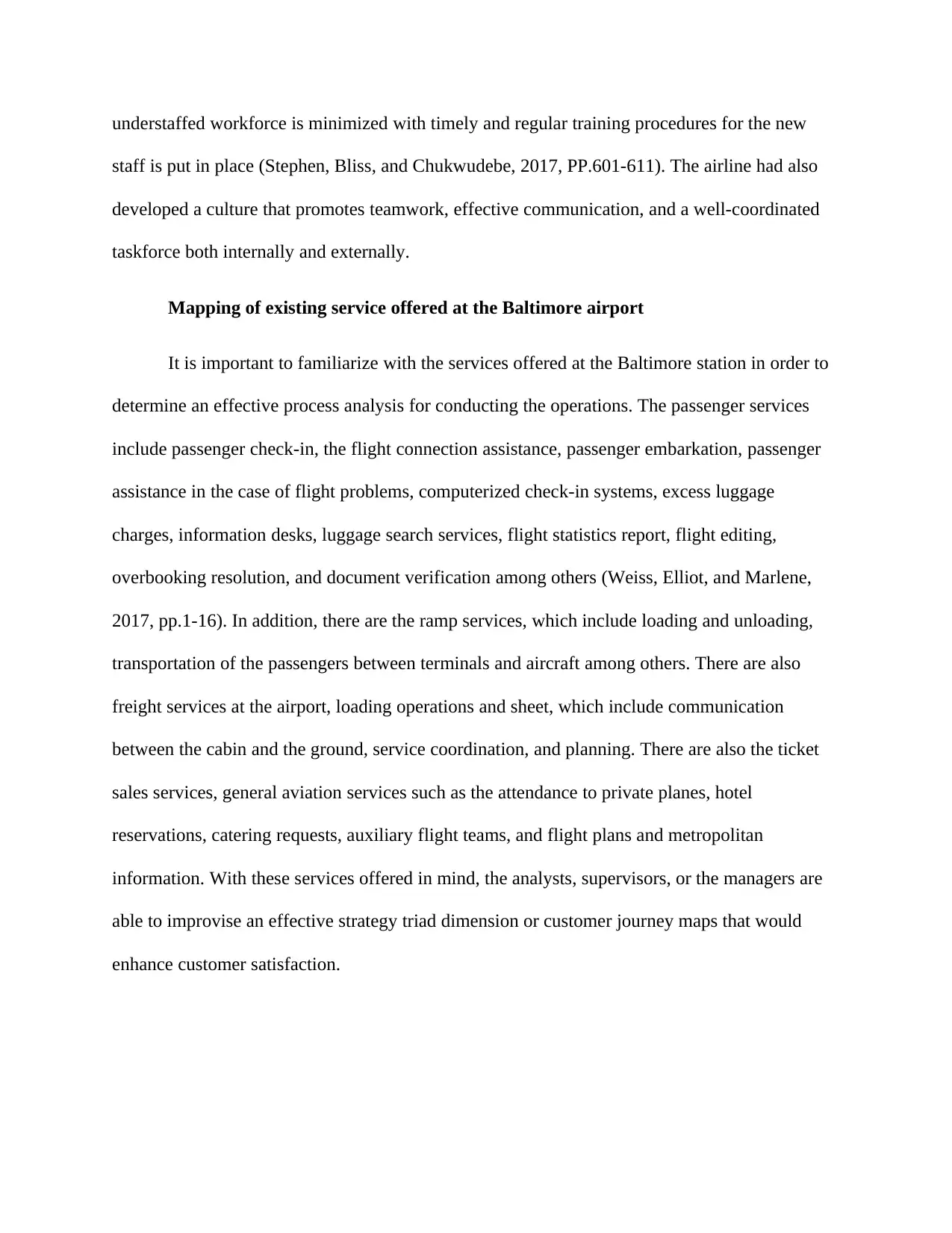
understaffed workforce is minimized with timely and regular training procedures for the new
staff is put in place (Stephen, Bliss, and Chukwudebe, 2017, PP.601-611). The airline had also
developed a culture that promotes teamwork, effective communication, and a well-coordinated
taskforce both internally and externally.
Mapping of existing service offered at the Baltimore airport
It is important to familiarize with the services offered at the Baltimore station in order to
determine an effective process analysis for conducting the operations. The passenger services
include passenger check-in, the flight connection assistance, passenger embarkation, passenger
assistance in the case of flight problems, computerized check-in systems, excess luggage
charges, information desks, luggage search services, flight statistics report, flight editing,
overbooking resolution, and document verification among others (Weiss, Elliot, and Marlene,
2017, pp.1-16). In addition, there are the ramp services, which include loading and unloading,
transportation of the passengers between terminals and aircraft among others. There are also
freight services at the airport, loading operations and sheet, which include communication
between the cabin and the ground, service coordination, and planning. There are also the ticket
sales services, general aviation services such as the attendance to private planes, hotel
reservations, catering requests, auxiliary flight teams, and flight plans and metropolitan
information. With these services offered in mind, the analysts, supervisors, or the managers are
able to improvise an effective strategy triad dimension or customer journey maps that would
enhance customer satisfaction.
staff is put in place (Stephen, Bliss, and Chukwudebe, 2017, PP.601-611). The airline had also
developed a culture that promotes teamwork, effective communication, and a well-coordinated
taskforce both internally and externally.
Mapping of existing service offered at the Baltimore airport
It is important to familiarize with the services offered at the Baltimore station in order to
determine an effective process analysis for conducting the operations. The passenger services
include passenger check-in, the flight connection assistance, passenger embarkation, passenger
assistance in the case of flight problems, computerized check-in systems, excess luggage
charges, information desks, luggage search services, flight statistics report, flight editing,
overbooking resolution, and document verification among others (Weiss, Elliot, and Marlene,
2017, pp.1-16). In addition, there are the ramp services, which include loading and unloading,
transportation of the passengers between terminals and aircraft among others. There are also
freight services at the airport, loading operations and sheet, which include communication
between the cabin and the ground, service coordination, and planning. There are also the ticket
sales services, general aviation services such as the attendance to private planes, hotel
reservations, catering requests, auxiliary flight teams, and flight plans and metropolitan
information. With these services offered in mind, the analysts, supervisors, or the managers are
able to improvise an effective strategy triad dimension or customer journey maps that would
enhance customer satisfaction.
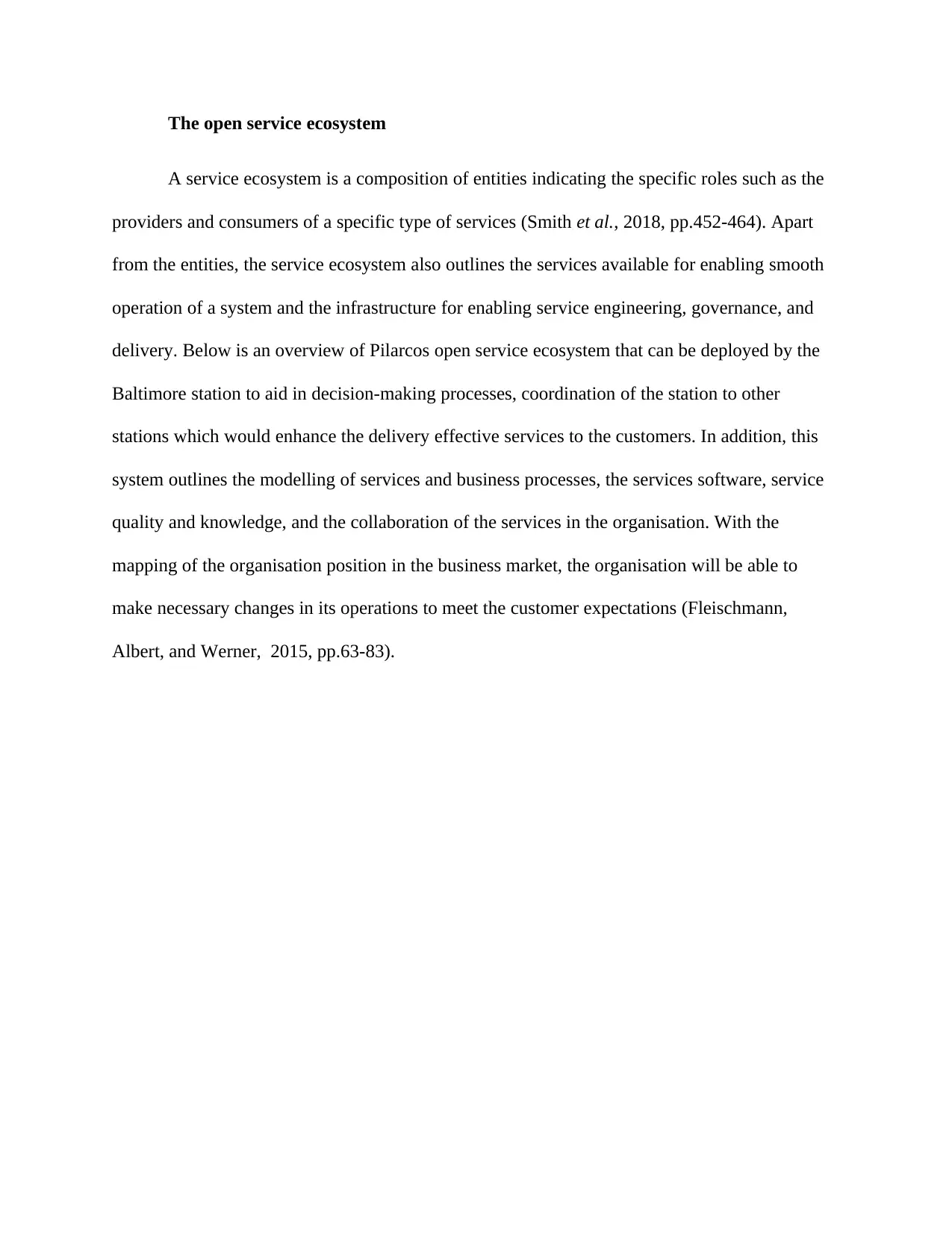
The open service ecosystem
A service ecosystem is a composition of entities indicating the specific roles such as the
providers and consumers of a specific type of services (Smith et al., 2018, pp.452-464). Apart
from the entities, the service ecosystem also outlines the services available for enabling smooth
operation of a system and the infrastructure for enabling service engineering, governance, and
delivery. Below is an overview of Pilarcos open service ecosystem that can be deployed by the
Baltimore station to aid in decision-making processes, coordination of the station to other
stations which would enhance the delivery effective services to the customers. In addition, this
system outlines the modelling of services and business processes, the services software, service
quality and knowledge, and the collaboration of the services in the organisation. With the
mapping of the organisation position in the business market, the organisation will be able to
make necessary changes in its operations to meet the customer expectations (Fleischmann,
Albert, and Werner, 2015, pp.63-83).
A service ecosystem is a composition of entities indicating the specific roles such as the
providers and consumers of a specific type of services (Smith et al., 2018, pp.452-464). Apart
from the entities, the service ecosystem also outlines the services available for enabling smooth
operation of a system and the infrastructure for enabling service engineering, governance, and
delivery. Below is an overview of Pilarcos open service ecosystem that can be deployed by the
Baltimore station to aid in decision-making processes, coordination of the station to other
stations which would enhance the delivery effective services to the customers. In addition, this
system outlines the modelling of services and business processes, the services software, service
quality and knowledge, and the collaboration of the services in the organisation. With the
mapping of the organisation position in the business market, the organisation will be able to
make necessary changes in its operations to meet the customer expectations (Fleischmann,
Albert, and Werner, 2015, pp.63-83).
⊘ This is a preview!⊘
Do you want full access?
Subscribe today to unlock all pages.

Trusted by 1+ million students worldwide
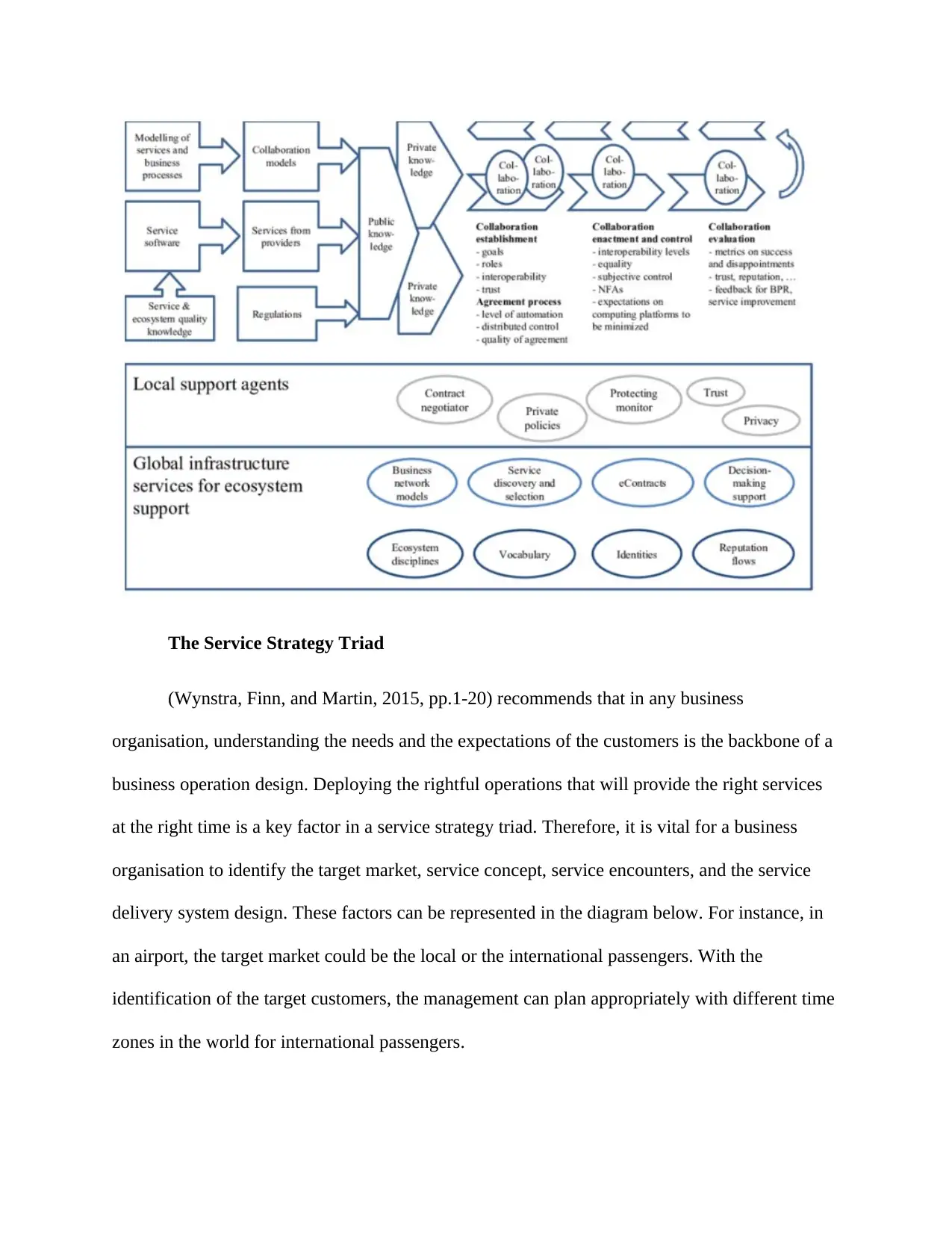
The Service Strategy Triad
(Wynstra, Finn, and Martin, 2015, pp.1-20) recommends that in any business
organisation, understanding the needs and the expectations of the customers is the backbone of a
business operation design. Deploying the rightful operations that will provide the right services
at the right time is a key factor in a service strategy triad. Therefore, it is vital for a business
organisation to identify the target market, service concept, service encounters, and the service
delivery system design. These factors can be represented in the diagram below. For instance, in
an airport, the target market could be the local or the international passengers. With the
identification of the target customers, the management can plan appropriately with different time
zones in the world for international passengers.
(Wynstra, Finn, and Martin, 2015, pp.1-20) recommends that in any business
organisation, understanding the needs and the expectations of the customers is the backbone of a
business operation design. Deploying the rightful operations that will provide the right services
at the right time is a key factor in a service strategy triad. Therefore, it is vital for a business
organisation to identify the target market, service concept, service encounters, and the service
delivery system design. These factors can be represented in the diagram below. For instance, in
an airport, the target market could be the local or the international passengers. With the
identification of the target customers, the management can plan appropriately with different time
zones in the world for international passengers.
Paraphrase This Document
Need a fresh take? Get an instant paraphrase of this document with our AI Paraphraser
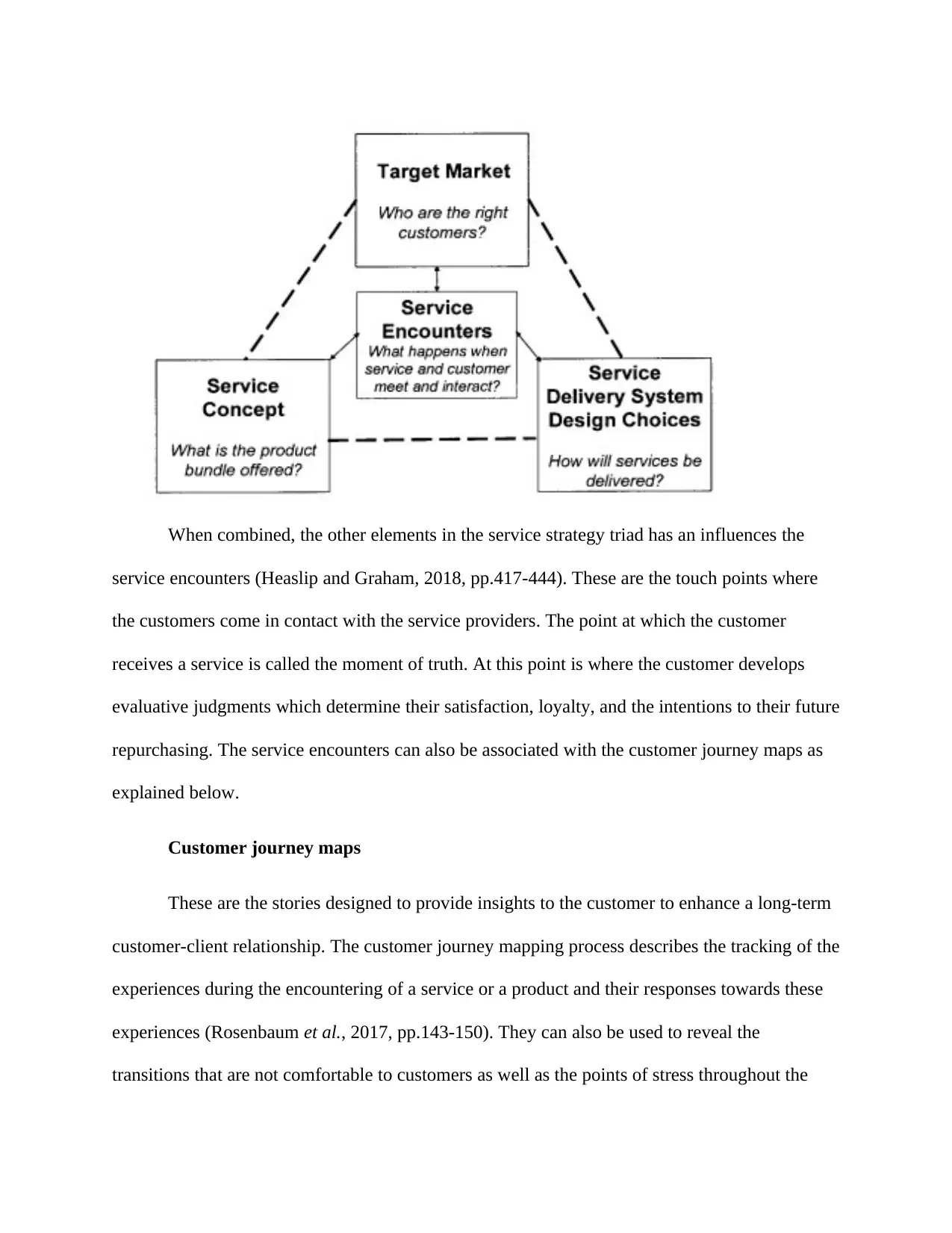
When combined, the other elements in the service strategy triad has an influences the
service encounters (Heaslip and Graham, 2018, pp.417-444). These are the touch points where
the customers come in contact with the service providers. The point at which the customer
receives a service is called the moment of truth. At this point is where the customer develops
evaluative judgments which determine their satisfaction, loyalty, and the intentions to their future
repurchasing. The service encounters can also be associated with the customer journey maps as
explained below.
Customer journey maps
These are the stories designed to provide insights to the customer to enhance a long-term
customer-client relationship. The customer journey mapping process describes the tracking of the
experiences during the encountering of a service or a product and their responses towards these
experiences (Rosenbaum et al., 2017, pp.143-150). They can also be used to reveal the
transitions that are not comfortable to customers as well as the points of stress throughout the
service encounters (Heaslip and Graham, 2018, pp.417-444). These are the touch points where
the customers come in contact with the service providers. The point at which the customer
receives a service is called the moment of truth. At this point is where the customer develops
evaluative judgments which determine their satisfaction, loyalty, and the intentions to their future
repurchasing. The service encounters can also be associated with the customer journey maps as
explained below.
Customer journey maps
These are the stories designed to provide insights to the customer to enhance a long-term
customer-client relationship. The customer journey mapping process describes the tracking of the
experiences during the encountering of a service or a product and their responses towards these
experiences (Rosenbaum et al., 2017, pp.143-150). They can also be used to reveal the
transitions that are not comfortable to customers as well as the points of stress throughout the
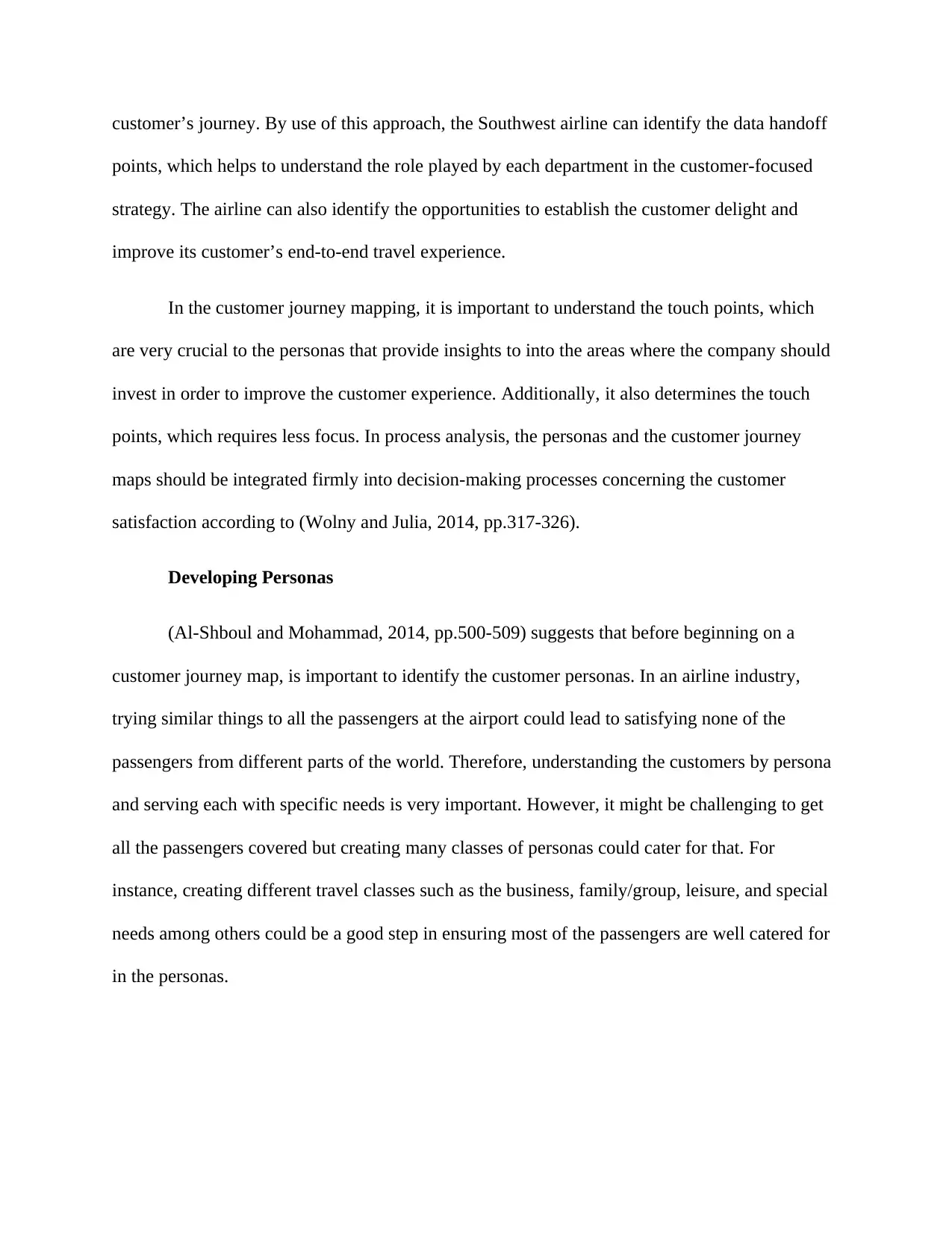
customer’s journey. By use of this approach, the Southwest airline can identify the data handoff
points, which helps to understand the role played by each department in the customer-focused
strategy. The airline can also identify the opportunities to establish the customer delight and
improve its customer’s end-to-end travel experience.
In the customer journey mapping, it is important to understand the touch points, which
are very crucial to the personas that provide insights to into the areas where the company should
invest in order to improve the customer experience. Additionally, it also determines the touch
points, which requires less focus. In process analysis, the personas and the customer journey
maps should be integrated firmly into decision-making processes concerning the customer
satisfaction according to (Wolny and Julia, 2014, pp.317-326).
Developing Personas
(Al-Shboul and Mohammad, 2014, pp.500-509) suggests that before beginning on a
customer journey map, is important to identify the customer personas. In an airline industry,
trying similar things to all the passengers at the airport could lead to satisfying none of the
passengers from different parts of the world. Therefore, understanding the customers by persona
and serving each with specific needs is very important. However, it might be challenging to get
all the passengers covered but creating many classes of personas could cater for that. For
instance, creating different travel classes such as the business, family/group, leisure, and special
needs among others could be a good step in ensuring most of the passengers are well catered for
in the personas.
points, which helps to understand the role played by each department in the customer-focused
strategy. The airline can also identify the opportunities to establish the customer delight and
improve its customer’s end-to-end travel experience.
In the customer journey mapping, it is important to understand the touch points, which
are very crucial to the personas that provide insights to into the areas where the company should
invest in order to improve the customer experience. Additionally, it also determines the touch
points, which requires less focus. In process analysis, the personas and the customer journey
maps should be integrated firmly into decision-making processes concerning the customer
satisfaction according to (Wolny and Julia, 2014, pp.317-326).
Developing Personas
(Al-Shboul and Mohammad, 2014, pp.500-509) suggests that before beginning on a
customer journey map, is important to identify the customer personas. In an airline industry,
trying similar things to all the passengers at the airport could lead to satisfying none of the
passengers from different parts of the world. Therefore, understanding the customers by persona
and serving each with specific needs is very important. However, it might be challenging to get
all the passengers covered but creating many classes of personas could cater for that. For
instance, creating different travel classes such as the business, family/group, leisure, and special
needs among others could be a good step in ensuring most of the passengers are well catered for
in the personas.
⊘ This is a preview!⊘
Do you want full access?
Subscribe today to unlock all pages.

Trusted by 1+ million students worldwide
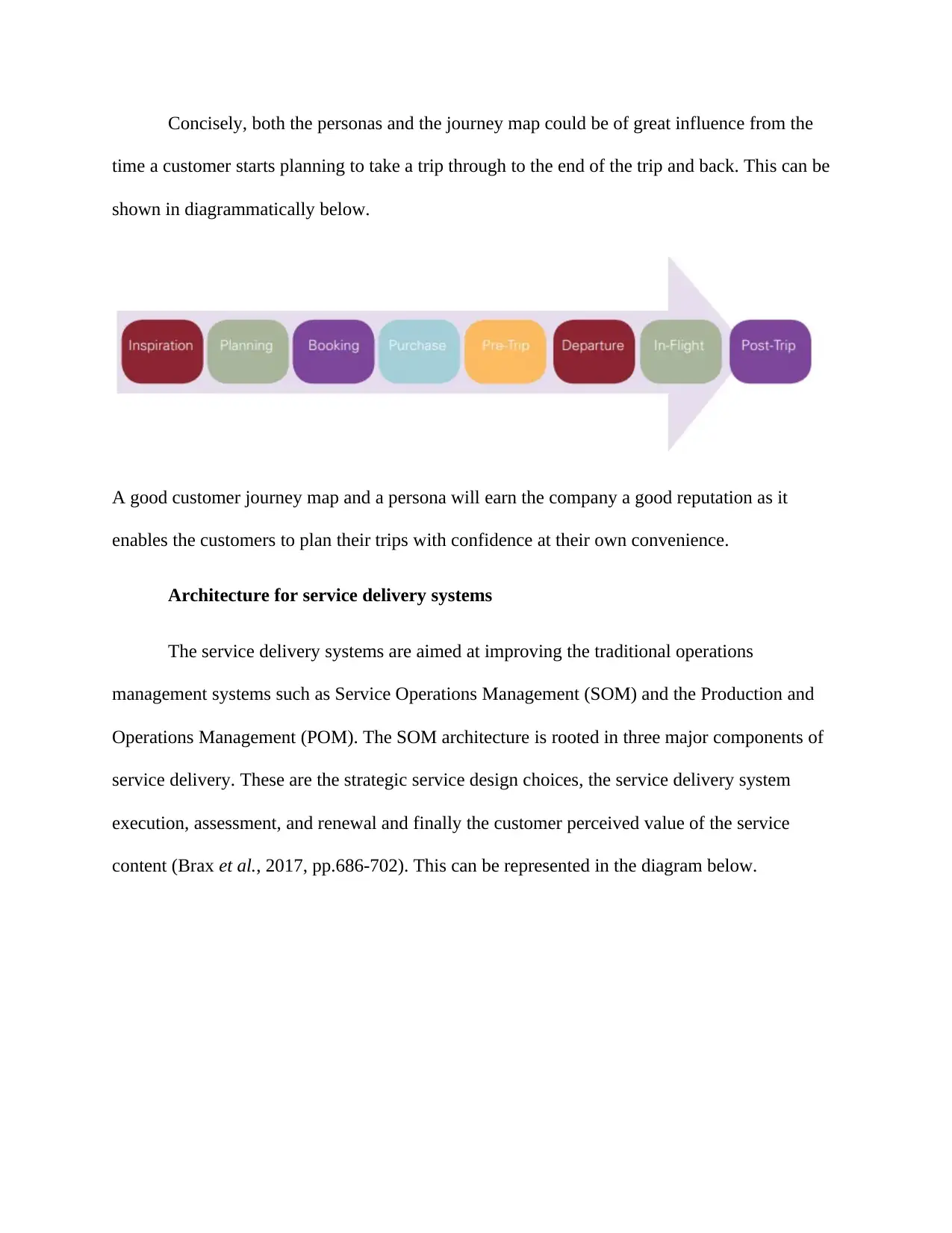
Concisely, both the personas and the journey map could be of great influence from the
time a customer starts planning to take a trip through to the end of the trip and back. This can be
shown in diagrammatically below.
A good customer journey map and a persona will earn the company a good reputation as it
enables the customers to plan their trips with confidence at their own convenience.
Architecture for service delivery systems
The service delivery systems are aimed at improving the traditional operations
management systems such as Service Operations Management (SOM) and the Production and
Operations Management (POM). The SOM architecture is rooted in three major components of
service delivery. These are the strategic service design choices, the service delivery system
execution, assessment, and renewal and finally the customer perceived value of the service
content (Brax et al., 2017, pp.686-702). This can be represented in the diagram below.
time a customer starts planning to take a trip through to the end of the trip and back. This can be
shown in diagrammatically below.
A good customer journey map and a persona will earn the company a good reputation as it
enables the customers to plan their trips with confidence at their own convenience.
Architecture for service delivery systems
The service delivery systems are aimed at improving the traditional operations
management systems such as Service Operations Management (SOM) and the Production and
Operations Management (POM). The SOM architecture is rooted in three major components of
service delivery. These are the strategic service design choices, the service delivery system
execution, assessment, and renewal and finally the customer perceived value of the service
content (Brax et al., 2017, pp.686-702). This can be represented in the diagram below.
Paraphrase This Document
Need a fresh take? Get an instant paraphrase of this document with our AI Paraphraser
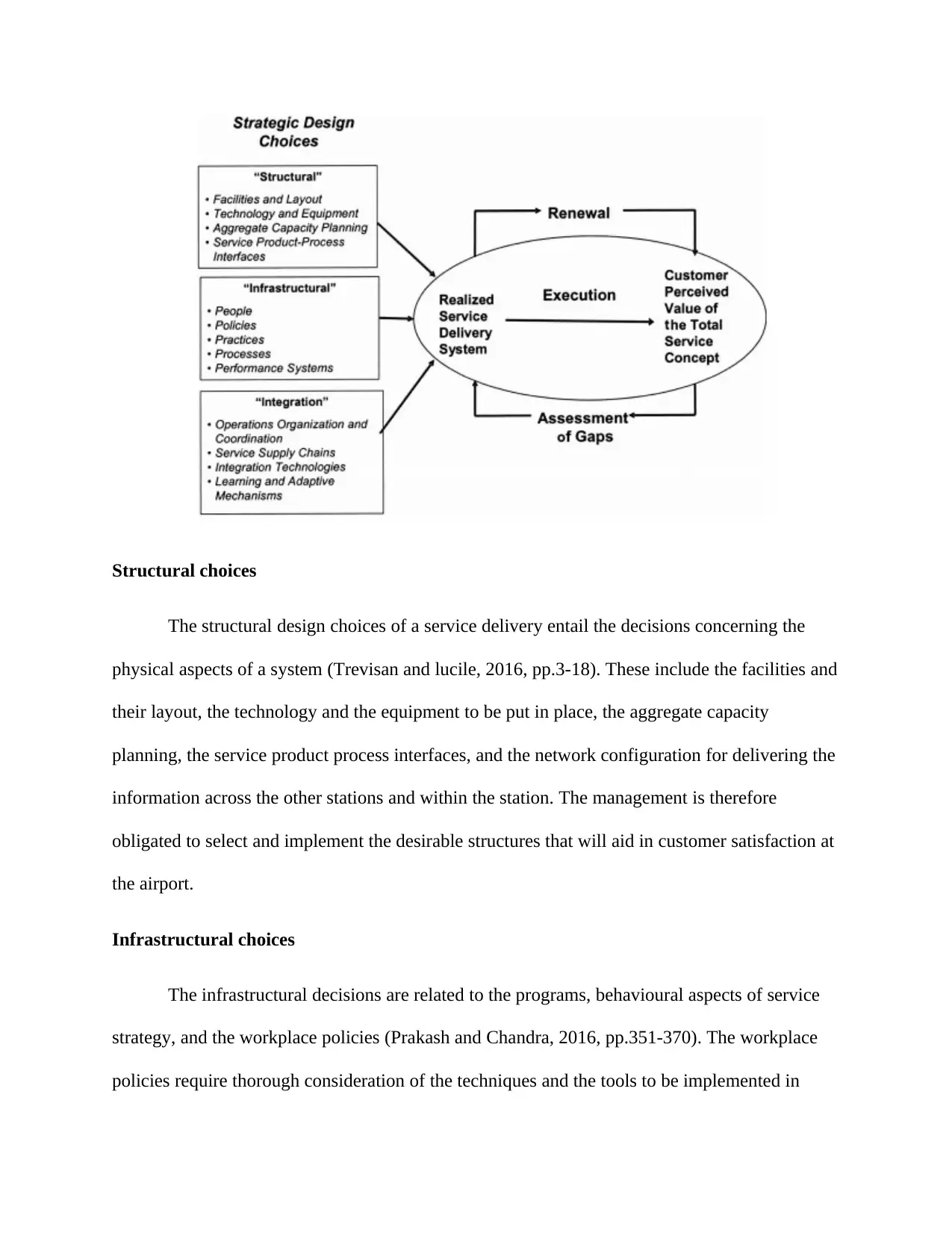
Structural choices
The structural design choices of a service delivery entail the decisions concerning the
physical aspects of a system (Trevisan and lucile, 2016, pp.3-18). These include the facilities and
their layout, the technology and the equipment to be put in place, the aggregate capacity
planning, the service product process interfaces, and the network configuration for delivering the
information across the other stations and within the station. The management is therefore
obligated to select and implement the desirable structures that will aid in customer satisfaction at
the airport.
Infrastructural choices
The infrastructural decisions are related to the programs, behavioural aspects of service
strategy, and the workplace policies (Prakash and Chandra, 2016, pp.351-370). The workplace
policies require thorough consideration of the techniques and the tools to be implemented in
The structural design choices of a service delivery entail the decisions concerning the
physical aspects of a system (Trevisan and lucile, 2016, pp.3-18). These include the facilities and
their layout, the technology and the equipment to be put in place, the aggregate capacity
planning, the service product process interfaces, and the network configuration for delivering the
information across the other stations and within the station. The management is therefore
obligated to select and implement the desirable structures that will aid in customer satisfaction at
the airport.
Infrastructural choices
The infrastructural decisions are related to the programs, behavioural aspects of service
strategy, and the workplace policies (Prakash and Chandra, 2016, pp.351-370). The workplace
policies require thorough consideration of the techniques and the tools to be implemented in
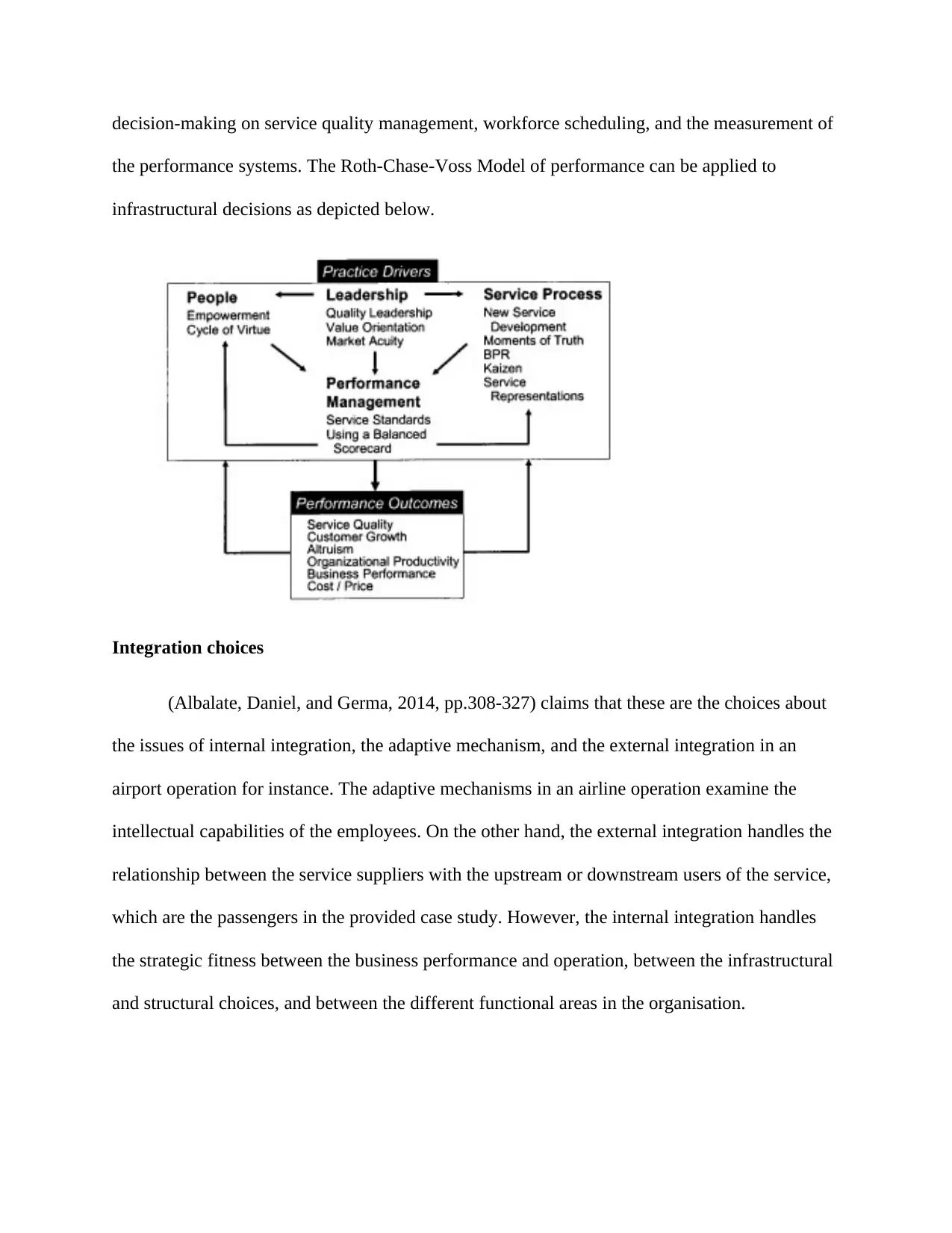
decision-making on service quality management, workforce scheduling, and the measurement of
the performance systems. The Roth-Chase-Voss Model of performance can be applied to
infrastructural decisions as depicted below.
Integration choices
(Albalate, Daniel, and Germa, 2014, pp.308-327) claims that these are the choices about
the issues of internal integration, the adaptive mechanism, and the external integration in an
airport operation for instance. The adaptive mechanisms in an airline operation examine the
intellectual capabilities of the employees. On the other hand, the external integration handles the
relationship between the service suppliers with the upstream or downstream users of the service,
which are the passengers in the provided case study. However, the internal integration handles
the strategic fitness between the business performance and operation, between the infrastructural
and structural choices, and between the different functional areas in the organisation.
the performance systems. The Roth-Chase-Voss Model of performance can be applied to
infrastructural decisions as depicted below.
Integration choices
(Albalate, Daniel, and Germa, 2014, pp.308-327) claims that these are the choices about
the issues of internal integration, the adaptive mechanism, and the external integration in an
airport operation for instance. The adaptive mechanisms in an airline operation examine the
intellectual capabilities of the employees. On the other hand, the external integration handles the
relationship between the service suppliers with the upstream or downstream users of the service,
which are the passengers in the provided case study. However, the internal integration handles
the strategic fitness between the business performance and operation, between the infrastructural
and structural choices, and between the different functional areas in the organisation.
⊘ This is a preview!⊘
Do you want full access?
Subscribe today to unlock all pages.

Trusted by 1+ million students worldwide
1 out of 17
Related Documents
Your All-in-One AI-Powered Toolkit for Academic Success.
+13062052269
info@desklib.com
Available 24*7 on WhatsApp / Email
![[object Object]](/_next/static/media/star-bottom.7253800d.svg)
Unlock your academic potential
Copyright © 2020–2025 A2Z Services. All Rights Reserved. Developed and managed by ZUCOL.





